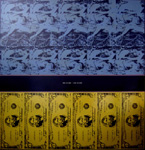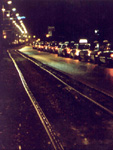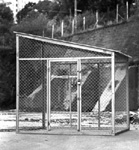medial 1. art biennial
[2005]
ART AND POLITICS IN NORWAY
I
A n
uncomplete introduction
by Evelyn
Holm
Victor Lindís work "CONTEMPORARY MEMORY
who is afraid", a video and sound installation in four synchronized parts,
was a remarkable statement which includes clues to the present condition of
Norwegian society, as well as it created a picture on a hidden part of
Norwegian war history. The video installation consisted of four huge
projections with changing texts, pictures and the colors red, blue and
yellow, an allusion, also in the title, to the American painter Barnett
Newmans series “Who is afraid of red, blue and yellow” from 1966-67. Barnett
Newman saw painting as a way of spiritual salvation necessary in a world
left in chaos after the second world war, and together with the use of a
poem of Paul Celan, whom according to Adorno was the poet that showed that
it still was possible to make poetry, i.e. art, after the traumas of the
war, it suggests artís capability of restoring, constructing and
reconstructing historical memory, individually and collectively. Of the four
videoís, the one in ordinary colors presents the official history of how 532
Norwegian Jews, with the help of Norwegian police, were sent to Auschwitz
early one morning in 1942. From this number, only 11 survived. An important
remark added to the story is that while only 0,7 % Jews were exterminated in
our neighboring country Denmark, the level in Norway was 44,8 %. The highly
traumatic story that develops through the four synchronized sections,
assisted by court documents and by research reports from historians, is
about a society that found the responsible Norwegian policeman not guilty
for his actions, and left him free to pursue his leading role in the police
force until he retired in 1965, i.e. less than 40 years ago, and as such
still part of our contemporary history. In fact, hundreds, even thousands of
Norwegians can be seen as sharing the responsibility of what happened to the
Jewish population; each of them only obeying orders and neglecting to warn
the victims, a few even in connection with their roles as double agents for
the Norwegian resistance movement. As such the topic of the work is
individual responsibility, or more precisely, what happens when individual
responsibility gets pulverized. The aesthetic composition of the
installation overwhelmingly surrounding the viewer, the hypnotic atmosphere
of the sounds and changing colors, talk as much to our subconscious and
imagination as to the intellect. By combining facts, speculations, poetry,
colors and sound, the aesthetics works together with the ethics, and create
a possibility to question our own sense of personal responsibility as we
sort out what all this is about.
Previous to the
installation, Lind made a memorial event in Oslo (1998); he ordered 100
taxicabs to the same address where the same number of taxicabs were used in
1942 to transport the Jews. The work had the title "CONTEMPORARY MEMORY I´ll
bring you home", and could most precisely be defined as a live installation
with certain ritualistic overtones; the place and time, even the weekday,
was the same as the situation of reference 56 years earlier. The late night
/ early morning passer-bys as well as the invited audience was met with
flashing yellow traffic lights and a 700 meters long line of taxis slowly
driving into the street. A historical document of the incident in 1942 was
handed out. The change in social belongings of the taxi drivers, as now many
of them are of a not European background, added to the workís potential of
reflection.
Victor Lind´s work
constitutes one of several peaks in a consistent production of politically
engaged artworks that go back to 1970, and establish the artist as a member
of the ìyoungî contemporary art scene, despite his sixty years of age. This
also contradicts the notion of young and contemporary as anything, which has
anything, to do with age. More important, the work creates a link between
our recent history and our current situation, to the importance of memory,
in a situation where right wing ideology and racism is rising in Norway as
well as in all Western Europe. The paradox of the term contemporary, which
refers to here and now, and memory, which refers to the past, reveals the
unavoidable truth that history is always a construction on hindsight, at
both a personal and collective level. The viewer herself is invited to make
her own opinions from the presented fragments filtering through the
sensibility of the artist. The impression is not that of a documentary, but
of a more or less hidden connection we have to sort out ourselves, althoug
it is admittedly difficult not to sympathize with the artistís experience.
ART. MARE ARTICUM 10-2002



